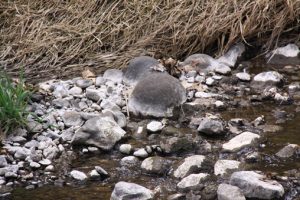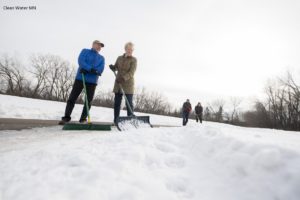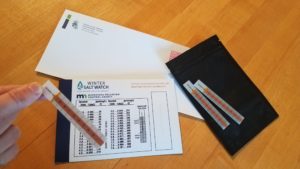Salt Watch Volunteers Needed
Help test for chloride in the Nine Mile Creek watershed

Nine Mile Creek needs your help!
In 2004, the MN Pollution Control Agency (MPCA) placed Nine Mile Creek on the impaired waters list for chloride. This means that there is too much chloride (a component of de-icing salt) in the creek, and it is impacting plants, fish, and other aquatic life. Road salt is a major source of chloride pollution to Nine Mile Creek. The District promotes smart salting through its education program.
What is Smart Salting?
Smart Salting aims to limit the amount of chloride people use while also keeping sidewalks, parking lots, and roads safe. When Smart Salting you should:
 Shovel first—Shovel early and shovel often! Remove snow before it turns to ice. This way you need less salt and the salt will be more effective.
Shovel first—Shovel early and shovel often! Remove snow before it turns to ice. This way you need less salt and the salt will be more effective.
Scatter—Scatter matters. More salt does not mean faster melting. Aim for space between the granules. You only need about of coffee cup of salt for about 10 sidewalk squares or a 20 foot driveway.
Switch—Most salt stops working when the pavement is 15 degrees Fahrenheit. So salt should not be applied. Instead, switch to sand for traction.
Sweep—Sweep up salt and sand on dry pavement before it enters our waters. You can reuse the salt later instead of letting it wash down the storm drain.
What can you do?

Take part in our Salt Watch – Winter Curbside program!
Volunteer to collect stormwater runoff chloride readings after snow melts. Collect this data to help the District locate chloride hotspots to target outreach about the impacts of salt on our waterbodies and steps to reduce these impacts.
The kit includes three chloride test strips to measure the chloride in melt water coming off parking lots or running down curbs. Volunteers will sample during a melt period or after rain. Sampling every two months is best, but you can sample anytime between November and April. Your data gets uploaded through the Water Reporter App and you are done! The kit comes with instructions to guide you through sampling and uploading data through the app.
This program was created in partnership with the Izaak Walton League of America.
